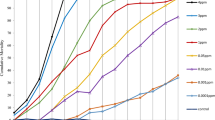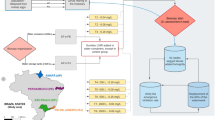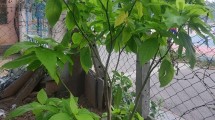Abstract
Purpose of Review
Aedes aegypti (L.) is the main vector of dengue, yellow fever, Zika, and chikungunya viruses in many parts of the world affecting millions of people worldwide each year. Its control is mostly aimed at the larval stages (removal of breeding sites, larviciding, and community education) to reduce the population of new adults. This review is a compilation of recent studies carried out in Argentina with the insect growth regulator (IGR) pyriproxyfen applied for controlling different life stages of the mosquito Aedes aegypti.
Recent Findings
Pyriproxyfen (PPF) is an increasingly used hormone analog that prevents juvenile Aedes mosquitoes from becoming adults and being incapable of transmitting dengue. It exhibits a high level of activity against mosquito larvae inhibiting adult emergence at very low doses. Additionally, effects on adult mosquito fecundity and fertility after IGR treatments were identified.
Summary
IGRs have been reported to be selective against target species, with considerable safety to the environment and nontarget organisms, including mammals. Its high efficacy as a larvicide at very low doses, together with its proven effects on adult reproduction, makes it an excellent candidate for use within an integrated vector management program.

Similar content being viewed by others
References
Papers of particular interest, published recently, have been highlighted as: • Of importance •• Of major importance
Vezzani D, Carbajo AE. Aedes aegypti, Aedes albopictus, and dengue in Argentina: current knowledge and future directions. Mem I Os Cr. 2008;103(1):66–74.
Pilger D, De Maesschalckm M, Horstick O, San Martin JL. Dengue outbreak response: documented effective interventions and evidence gaps. TropI KA. 2010;1(1):1–31.
World Health Organization (WHO). Handbook for integrated vector management. 2012.
Araújo AP, Araujo Diniz DF, Helvecio E, Arruda de Barros R, Fontes de Oliveira CM, Junqueira Ayres CF, et al. The susceptibility of Aedes aegypti populations displaying temephos resistance to Bacillus thuringiensis israelensis: a basis for management. Parasit Vectors. 2013;6:297.
Grisales N, Poupardin R, Gomez S, Fonseca-Gonzalez I, Ranson H, Lenhart A. Temephos resistance in Aedes aegypti in Colombia compromises dengue vector control. PLoS Negl Trop Dis. 2013;7(9):e2438.
Llinás AG, Seccacini E, Gardenal CN, Licastro S. Current resistance status to temephos in Aedes aegypti from different regions of Argentina. Mem Inst Oswaldo Cruz. 2010;105:113–6.
Valle D, Fernandes BD, Fernandes Viana-Medeiros P, Pereira Lima JB, Martins Junior AJ. Resistance to temephos and deltamethrin in Aedes aegypti from Brazil between 1985 and 2017. Mem Inst Oswaldo Cruz. 2019;114:e180544.
Su T. Resistance and resistance management of biorational larvicides for mosquito control. J Florida Mosquito Control Assoc. 2022; 69(1).
Biber PA, Dueñas JR, Almeida FL, Gardenal CN, Almirón WR. Laboratory evaluation of susceptibility of natural subpopulations of Aedes aegypti larvae to temephos. J Am Mosquito Contr. 2006;22(3):408–11.
Seccacini E, Lucia A, Zerba E, Licastro S, Masuh H. Aedes aegypti (L.): resistance to temephos in Argentina. J Am Mosquito Contr. 2008;24:608–9.
World Health Organization (WHO).Guidelines for drinking-water quality - 4th ed. 2011.
Hoffmann KHY, Lorenz MW. Recent advances in hormones in insect pest control. Phytoparasitica. 1998;26(4):323–30.
Tunaz H, Uygun N. Insect Growth regulators for Insect Pest Control. Turk J Agri. 2004;28:377–87.
Graf. The role of insect growth regulators in arthropod control. Parasitol Today. 1993; 9(12): 471–474.
Su T, Mulla MS, Zaim M. Laboratory and field evaluations of novaluron, a new insect growth regulator (IGR), against Culex mosquitoes. J Am Mosquito Contr. 2003;19(4):408–18.
Batraa CP, Mittala PK, Adaka T, Ansarib MA. Efficacy of IGR compound Starycide 480 SC (Triflumuron) against mosquito larvae in clear and polluted water. J Vect Borne Dis. 2005;42:109–16.
Lawler SP. Environmental safety review of methoprene and bacterially-derived pesticides commonly used for sustained mosquito control. Ecotox Environ Safe. 2017;139:335–43.
• Hustedt JC, Boyce R, Bradley J, Hii J, Alexander N. Use of pyriproxyfen in control of Aedes mosquitoes: a systematic review. PLOS Neglect Trop D. 2020;14(6):e0008205. (Hustedt et al. wrote a review of the effect of PPF on a range of endpoints, including percentage inhibition of emergence, larval mortality, and resistance levels. The different uses, strengths, and limitations of PPF in vector control of Aedes are discussed.)
Tsunoda T, Nguyen DT, Quyen TV, Vu DT, Tran PV, Minakawa N. Effects of long-lasting pyriproxyfen formulation on biotic attractant factors for egg-laying in Aedes aegypti and Aedes albopictus (Diptera: Culicidae). Med Entomol Zool. 2021;72(4):221–8.
Miura T, Schaeffer CH, Takahashi RM, Mulligan FS. Effects of the insect growth inhibitor, Dimilin, on hatching of mosquito eggs. J Econ Entomol. 1976;69:655–8.
Fournet F, Sannier C, Monteny N. Effects of the insect growth regulators OMS and diflubenzuron on the reproductive potencial of Aedes aegypti. J Am Mosq Control Assoc. 1993;9(4):426–30.
Belinato TA, Martins AJ, Pereira Lima JB, Nunes de Lima-Camara T, AfrânioPeixoto A, Valle D. Effect of the chitin synthesis inhibitor triflumuron on the development, viability and reproduction of Aedes aegypti. Mem Inst Oswaldo Cruz. 2009;104(1):43–7.
Harburguer L, Zerba E, Licastro S. Sublethal effect of pyriproxyfen released from a fumigant formulation on fecundity, fertility and ovicidal action in Aedes aegypti (Diptera: Culicidae). J Med Entomol. 2014;51(2):436–43.
Gonzalez PV, Harburguer L. Lufenuron can be transferred by gravid Aedes aegypti females to breeding sites and can affect their fertility, fecundity and blood intake capacity. Parasite Vector. 2020;13(1):1–8.
Alomar AA, Alto BW. Evaluation of pyriproxyfen effects on Aedes aegypti and predatory mosquito Toxorhynchites rutilus (Diptera: Culicidae). J Med Entomol. 2022;59(2):585–90.
Hirano M, Hatakoshi M, Kawada H, Takimoto Y. Pyriproxyfen and other juvenile hormone analogues. Rev Toxicol. 1998;2:357–94.
Ayesa P, Harrington LC, Scott JG. Evaluation of novel insecticides for control of dengue vector Aedes aegypti (Diptera: Culicidae). J Med Entomol. 2006;43(1):55–60.
Mishra A. Effect of pyriproxyfen against Dipterans as a growth regulator. International J Multidisciplinary Res. 2022; 10 (3).
Itaya N. Insect juvenile hormone analogue as an insect growth regulator. Sumitomo Pyrethroid World. 1987;8:2–4.
Vennard C, Nguama B, Dillon RJ, Oouchi H, Charnley AK. Effects of the juvenile hormone mimic pyriproxyfen on egg development, embryogenesis, larval development, and metamorphosis in the desert locust Schistocerca gregaria (Orthoptera: Acrididae). J Econ Entomol. 1998;91(1):41–9.
Yadav K, Dhiman S, Acharya B, Ghorpade RR, Sukumaran D. Pyriproxyfen treated surface exposure exhibits reproductive disruption in dengue vector Aedes aegypti. PLoS Negl Trop Dis. 2019;13(11):e0007842.
Harburguer L, Seccacini E, Masuh H, Gonzalez Audino P, Zerba E, Licastro S. Thermal behaviour and biological activity against Aedes aegypti (Diptera: Culicidae) of permetrhin and pyriproxyfen in a smoke-generating formulation. Pest Managment Science. 2009;65:1208–14.
Harburguer LV. Efectos letales y subletales de una pastilla fumígena conteniendo permetrina y pyriproxyfen sobre Aedes aegypti (Díptera: Culicidae) Tesis para optar al título de Doctor de la Universidad de Buenos Aires en el área: Ciencias Biológicas. 2011.
Lan Q, Grier CA. Critical period for pupal commitment in the yellow fever mosquito. Aedes aegypti J Insect Physiol. 2004;50:667–76.
Seccacini E, Lucia A, Harburguer L, Zerba E, Licastro S, Masuh H. Effectiveness of pyriproxyfen and diflubenzuron formulations as larvicides against Aedes aegypti. J Am Mosq Control Assoc. 2008;24(3):398–403.
Masuh H, Seccacini E, Licastro S, Zerba E. A new aqueous concentrate suspension of cis-permethrin and its insecticidal activity. Pest Sci. 2000;56:1–4.
Seccacini E, Masuh H, Licastro S, Zerba E. Laboratory and scaled up evaluation of cis-permethrin applied as a new ultralow volume formulation against Aedes aegypti (Diptera: culicidae). Acta Trop. 2006;97:1–4.
Lucia A, Harburguer L, Susana L, Zerba E, Masuh H. Efficacy of a new combined larvicidal-adulticidal ultra-low volume formulation against Aedes aegypti (Diptera: Culicidae), vector of dengue. Parasitol Res. 2009;104:1101–7.
DanturJuri MJ, Zaidenberg M, Santana M. The efficacy of a combined larvicide–adulticide in ultralow volume and fumigant canister formulations in controlling the dengue vector Aedes aegypti (Diptera: Culicidae) in Northwest of Argentina. Parasitol Res. 2013;112(3):1237–46.
Harburguer L, Beltrán G, Goldberg L, Goldberg L, Zerba E, Licastro S, et al. A new strategy for Aedes aegypti (Diptera: Culicidae) control with community participation using a new fumigant formulation. J Med Entomol. 2011;48(3):577–83.
Klowden MJ. Endocrine aspects of mosquito reproduction. Arch Insect Biochem Physiol. 1997;35:491–512.
Mulla MS, Darwazeh HA, Norland RL. Insect growth regulators: evaluation procedure and activity against mosquitoes. J Econ Entomol. 1974;67:329–32.
Telang A, Li Y, Noriega FG, Brown MR. Effects of larval nutrition on the endocrinology of mosquito egg development. J Exp Biol. 2006;209:645–55.
Itoh T, Kawada K, Abe A, Eshita Y, Rongsriyam Y, Igarashi A. Utilization of blood fed females of Aedes aegypti as a vehicle for the transfer of the insect growth regulator pyriproxyfen to larval habitats. J Am Mosq Control Assoc. 1994;10:344–7.
Corbet PS, Chadee DD. An improved method for detecting substrate preferences shown by mosquitoes that exhibit ‘skip oviposition.’ Physiol Entomol. 1993;18:114–8.
Chan KL. The eradication of Aedes aegypti at the Singapore Paya Lebar International Airport. In Vector Control in Southeast Asia. Proceedings of the 1st Seameo-Trop Med. Workshop. 1972; 85–88.
Perich MJ, Kardec A, Braga IA, Portal IF, Burge R, Zeichner BC, Brogdan WA, Wirtz RA. Field evaluation of a lethal ovitrap against dengue vectors in Brazil. J Med Vet Entomol. 2003;17:205–10.
Regis L, Monteiro AM, de Melo-Santos MAV, Silveira JC Jr, Furtado AF, Acioli RV, Santos GM, Nakazawa M, Carvalho MS, Ribeiro PJ, de Souza WV. Developing new approaches for detecting and preventing Aedes aegypti population outbreaks: basis for surveillance, alert and control system. Mem Inst Oswaldo Cruz. 2008;103:50–9.
Rapley LP, Johnson PH, Williams CR, Silcock RM, Larkman M, Long SA, Russell RC, Ritchie SA. A lethal ovitrap-based mass trapping scheme for dengue control in Australia: II. Impact on populations of the mosquito Aedes aegypti. Med Vet Entomol. 2009;23:303–16.
Ritchie S, Rapley LP, Benjamin S. Bacillus thuringiensis var. israelensis (Bti) provides residual control of Aedes aegypti in small containers. Am J Trop Med Hyg. 2010;82:1053–9.
Jahan N, Sarwar MS. Field evaluation of lethal ovitraps for the control of dengue vectors in Lahore. Pakistan Pakistan J Zool. 2013;45:305–15.
Caputo B, Ienco A, Cianci D, Pombi M, Petrarca V, Baseggio A, et al. The “auto-dissemination” approach: a novel concept to fight Aedes albopictus in urban areas. PLoS Negl Trop Dis. 2012;6:e1793.
Ohba SY, Ohashi K, Pujiyati E, Higa Y, Kawada H, Mito N, Takagi M. The effect of pyriproxyfen as a “population growth regulator” against Aedes albopictus under semi-field conditions. PLoS ONE. 2013;8:e67045.
•• Devine GJ, Perea EZ, Killeen GF, Stancil JD, Clark SJ, Morrison AC. Using adult mosquitoes to transfer insecticides to Aedes aegypti larval habitats. Proc Natl Acad Sci USA. 2009;106:11530–4. (Devine et al. described the first evidence that female mosquitos can acquire pyriproxyfen when landing on a treated surface and then transfer it to breeding sites, killing larvae.)
Ponlawat A, Fansiri T, Kurusarttra S, Pongsiri A, McCardle PW, Evans BP, et al. Development and evaluation of a pyriproxyfen-treated device to control the dengue vector, Aedes aegypti (L.) (Diptera: Culicidae). Southeast Asian J Trop Med Public Health. 2013;44:167–78.
Snetselaar J, Andriessen R, Suer RA, Osinga AJ, Knols BGJ, Farenhorst M. Development and evaluation of a novel contamination device that target multiple life-stages of Aedes aegypti. Parasit Vectors. 2014;7:200.
Harburguer L, Licastro S, Masuh H, Zerba E. Biological and chemical characterization of a new larvicide ovitrap made of plastic with pyriproxyfen incorporated for Aedes aegypti (Diptera: Culicidae) control. J Med Entomol. 2016;53(3):647–52.
Gomez A, Seccacini E, Zerba E, Licastro S. Comparison of the insecticide susceptibilities of laboratory strains of Aedes aegypti and Aedes albopictus. Mem do Inst Oswaldo Cruz. 2011;106:993–6.
Hirano M, Hatakoshi M, Kawada H, Takimoto Y. Pyriproxyfen and other juvenile hormone analogues. Rev Toxicol. 1998;2:357–94.
Ayesa P, Harrington L, Scott J. Evaluation of novel insecticides for control of dengue vector Aedes aegypti (Diptera: Culicidae). J Med Entomol. 2006;43:55–60.
Itaya N. Insect juvenile hormone analogue as an insect growth regulator. Sumitomo Pyrethroid World. 1987;8:2–4.
Koehler PG, Patterson RJ. Incorporation of pyriproxyfen in a German cockroach management program. J Econ Entomol. 1991;84:917–21.
Sihuincha M, Zamora-Perea E, Orellana-Rios W, Stancil JD, López Si fuentes V, Vidal-Oré C, et al. Potential use of pyriproxyfen for control of Aedes aegypti (Diptera: Culicidae) in Iquitos Perú. J Med Entomol. 2005;42:620–30.
Dell Chism B, Apperson C. Horizontal transfer of the insect growth regulator pyriproxyfen to larval microcosms by gravid Aedes albopictus and Ochlerotatus triseriatus mosquitoes in the laboratory. Med Vet Entomol. 2003;17:211–20.
Devine GJ, Zamora Perea E, Killeen GF, Stancil JD, Clark SJ, Morrison AC. Using adult mosquitoes to transfer insecticides to Aedes aegypti larval habitats. Proc Natl Acad Sci USA. 2009;106:11530–4.
Lima JBP, Melo NVD, Valle D. Residual effect of two Bacillus thuringiensis var. israelensis products assayed against Aedes aegypti (Diptera: Culicidae) in laboratory and outdoors at Rio de Janeiro. Brazil Rev Inst Med Trop SP. 2005;47:125–30.
Reynoso MM, Alzogaray RA, Harburguer LV, Gonzalez PV, Lucía A, Masuh HM, et al. Smoke bombs, ovitraps and other low environmental impact tools for controlling kissing bugs and mosquitoes. Revista de Salud Ambiental. 2022;22(1):61–70.
Acknowledgements
This study received financial support by the ANPCyT of Argentina (PICT 2017-1788/PICT 2018-0898). P.V.G. and L.V.H. are members of the CONICET (Consejo Nacional de Investigaciones Científicas y Técnicas). J.V.M has a grant from CONICET.
Author information
Authors and Affiliations
Corresponding author
Ethics declarations
Conflict of Interest
The authors declare no conflict of interest.
Human and Animal Rights and Informed Consent
This article does not contain any studies with human or animal subjects performed by any of the authors.
Additional information
Publisher's Note
Springer Nature remains neutral with regard to jurisdictional claims in published maps and institutional affiliations.
This article is part of the Topical Collection on Updates in Parasitology from Argentina.
Rights and permissions
Springer Nature or its licensor (e.g. a society or other partner) holds exclusive rights to this article under a publishing agreement with the author(s) or other rightsholder(s); author self-archiving of the accepted manuscript version of this article is solely governed by the terms of such publishing agreement and applicable law.
About this article
Cite this article
Harburguer, L.V., Mendoza, J. & Gonzalez, P.V. A Review of the Use of Pyriproxyfen for Controlling Aedes aegypti in Argentina. Curr Trop Med Rep 9, 261–266 (2022). https://doi.org/10.1007/s40475-022-00278-1
Accepted:
Published:
Issue Date:
DOI: https://doi.org/10.1007/s40475-022-00278-1




